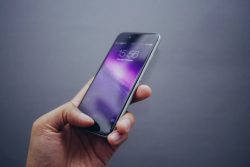This content was published: October 12, 2020. Phone numbers, email addresses, and other information may have changed.
Working with Students on Mobile
Posted by casey.twining
The Call for Equitable Access

photo by @ultralinx at Unsplash
It is safe to say the closure of in-person classes has challenged the way in which we conduct teaching and learning at PCC, and across the nation. As instructors dig deep for creative solutions, many have come to realize more fully the question of equitable access for students when it comes to content and coursework. We know the national trends bend toward increased use of mobile devices and data connections, even before the Coronavirus eliminated key campus access points for students like campus labs, libraries, and WiFi. These known factors point out a need to think about students and their mobile devices and how we can best meet the needs of students while retaining academic rigor.
“A growing share of Americans now use smartphones as their primary means of online access at home. Today, roughly one-in-five American adults are “smartphone-only” internet users – meaning they own a smartphone, but do not have traditional home broadband service.” pewresearch.org, 2019
For those just who are interested but just getting started looking at this, here are some ways to begin (adapted from Seilhamer et al):
- Use LMS tools whenever possible: PCC uses D2L Brightspace, and the app version is called “Brightspace Pulse.”
- “Chunk” content for brief sessions: Split up content for brief sessions, such as micro lectures, short activities and reflections.
- Keep file sizes small: Compress documents or chunk when possible, but also reduce the size of photo and video files before you upload to D2L.
- Add descriptors for time management: To help students know if they have enough time to get through a whole reading or activity, add the number of pages or approximate time to complete.
- Inform students if a piece of content won’t be available on mobile, does not work well on mobile, or requires an additional app.
- Demo the technology: Create your own technology demonstration videos (or find ready-made in a pinch)
- Consider accepting Google Docs links: Google Docs is perhaps an easier app to use than Microsoft Word and students can submit a link, rather than using valuable space to download a file to submit it. To allow a Google Docs link in lieu of an attached file, create a text submission assignment, rather than a file submission, and students who work in Microsoft Word still have the option of pasting their text inside, since it cannot be file and text submission (if this is confusing, feel free to contact the Faculty Help Desk at 971-722-8227)
Online Learning has standalone trainings, and is also partnering with Sylvania and Rock Creek TLCs to offer a five-week intensive if you are interested to dive a bit deeper:
- Mobile-Friendly Course Design Workshop Recording & Slides
- Rock Creek TLC + Online Learning Session on Mobile Design Slideshow
There are also great resources from Educase and others as the question of ubiquitous mobile learning is pushed to the forefront. The first step and most pressing step is to transform content so that it’s easily accessed, but with the seamless learning potential of mobile devices there is still plenty more ground to explore.
